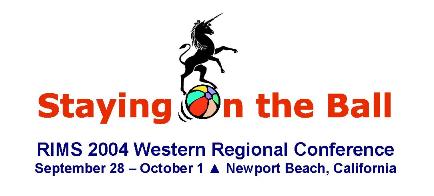 Risk
and Insurance Management Society, Inc. Risk
and Insurance Management Society, Inc. Los Angeles Chapter |
L.A. RIMS NEWS The Newsletter for Risk and Insurance Management Professionals |
| L.A. RIMS News September 2004 |
|
||||||||
|
President's Message This year’s meeting again focused on the expectation of our membership, and how, as the Board, we can add value to our organization. The answer is very simple: providing our fellow risk managers the ability to exchange ideas, learn about current events within the risk management community, and to provide a networking opportunity with our counterparts. The educational opportunities within the organization are many and include monthly luncheons, annual conferences, and an annual RIMS National Conference. In addition, the Chapter financially supports other educational activity such as scholarships and reimbursement for educational designations such as the ARM or CPCU. So how can we improve our Chapter? One way is to hear from our Chapter members. I would like to encourage our membership to provide feedback on what you like and what you don’t like by emailing me at Michael.Carlin@Jacobs.com I will keep the senders of the emails confidential, but hopefully be able to present to the Board the good things about our Chapter and areas of improvement. One other topic is to invite everyone to our upcoming “Friends and Associates of L.A. RIMS” event at the Los Angeles Times, 202 West 1st Street, in Los Angeles. The luncheon starts at 11:30 a.m. and ends around 2:00 p.m. During the year we receive substantial support from our Friends and this is an opportunity for both the Board and the membership to say thank you. Hope to see you there.
Michael Carlin |
|||||||||
|
Chapter Clips |
|||||||||
|
RIMS 2004 Western Regional Conference
HAVE YOU REGISTERED YET? The Southern California Chapters of RIMS Cordially Invite You to the RIMS 2004 Western Regional Conference Registration for the conference is now open! Don’t delay, just go to http://www.larims.org/conference for the program schedule, registration, and additional information. Register today before it’s too late!
This conference provides the ideal setting for risk management professionals to gather and share knowledge, discuss current trends and issues with experts and peers, provide motivation to implement new techniques, and enhance your risk management career. The conference is open to RIMS members only, which includes primary, secondary, and additional deputies as well as those who qualify for membership but have not yet joined. ~~~~~~~~~~~~~~~~~~~~~~~~~~~~~~~~~~~~~~~~~~~~~~~~~~~~~~~~~~~~~ If air travel is required to attend this conference, please note that the Hyatt Newporter provides complimentary transportation to and from John Wayne Airport (SNA) in Santa Ana, California. Go to http://www.ocair.com for more information regarding this airport and other available ground transportation options.
~~~~~~~~~~~~~~~~~~~~~~~~~~~~~~~~~~~~~~~~~~~~~~~~~~~~~~~ Included in this registration packet are the following items: Registration Form and Schedule of Sessions~~~~~~~~~~~~~~~~~~~~~~~~~~~~~~~~~~~~~~~~~~~~~~~~~~~~~~~ Important Dates: Early Bird Registration postmarked on or before July 30 Standard Registration postmarked July 31 thru September 7 Late Registration postmarked September 8 thru September 24 (Please refer to registration form for prices)
GOODY BAG DONATIONSCorporate member donations only; no vendors please.
The Western Regional Conference Committee is looking for
“goody bag” items to be included in registration bags that will be distributed
to conference attendees. Please send an email to
kmerkovsky@portla.org noting the items your company
would like to donate. Additional information will be provided upon receipt
of your email. Thank you for your anticipated generosity! Hawaii Captive Insurance Seminar Hawaii is coming to Newport Beach! Well, at least their captive seminar is. It is a one-day event on September 28th. Go to their website at http://www.hawaiicaptives.com for more information. Click on http://www.hawaiicaptives.com/news/pdf/newport04_program.pdf |
|||||||||
| Health & Safety | |||||||||
|
DOL Grants to Aid Disabled
Workforce The U.S. Department of Labor (DOL) has announced 25 grants totaling $8.1 million to help workers with disabilities access services offered at One-Stop Career Centers across the United States. The grants are designed to enhance the delivery of service by the DOL centers. Grant recipients will focus on using "navigators", specially trained staff members who will ensure that clients with disabilities have access to available employment and training tools. The government's efforts in this regard are part of a wide-ranging program known as New Freedom Initiative to recognize the employment potential of Americans with disabilities. The One-Stop Career Centers, established in 1998, offer a variety of resources for those seeking work. Among them are:
To learn more about the centers, including their locations, visit http://www.servicelocator.org. Group Offers State-by State Comp Stats The Work Loss Data Institute (WLDI) has published its 2004 State Report Cards for Workers' Comp, which offers a rating of state-by-state workers' compensation performance. It is intended to provide valuable information for employers, insurers, state governments, and consultants. The report found that the state with the most improved workers' comp performance between 2002 and 2003 was Alabama. Other states that ranked high were Utah, Indiana, Minnesota, Georgia, Iowa, and Virginia. A variety of outcomes were reviewed, including prevention and safety efforts, return-to-work, and disability durations. To review the entire report, visit http://www.odg-disability.com. OSHA, Disaster Cleanup Company Now Allied OSHA has teamed up with one of the nation's largest disaster restoration companies to further the safety and health of workers in the construction and restoration industries. BELFOR USA, Part of a global business that provides property recovery services throughout North America, signed an alliance with the agency. The agreement will concentrate on a variety of health and safety issues, and will focus on increasing access to worker protection information for employees with limited or no English-speaking capability. BELFOR and OSHA will create and disseminate training and education programs on mold removal practices, personal protective equipment, and safe driving. The programs are intended to benefit employees of BELFOR as well as other restoration businesses. The participants will spread the word through the media, including their respective websites, and will work together on creation of a Web-based motor vehicle training tool. BELFOR has 43 offices and 1,400 employees across the country. OSHA Unveils New Whistleblower Web Page OSHA last month launched a whistleblower program page on its website to provide a single source for detailed information on the laws that include whistleblower protection that is administered by the agency. The page consolidates a variety of information previously available elsewhere on the site, plus access to other resources. Direct links are provided to the 14 laws with whistleblower protections administered by OSHA; procedures for handling complaints under the various statues are included as well. Details about filing workplace discrimination complaints are provided, as is direct access to five separate OSHA fact sheets on the whistleblower program. OSHA's whistleblower responsibilities have expanded from one segment of the OSH Act to a total of 14 laws. The latest are the Corporate and Criminal Fraud Accountability Act of 2002 and the pipeline Safety improvement Act of 2002. California State's Paid Medical Leave Program Now Under Way As of July 1, employees could begin taking advantage of the Paid Family Leave Law in California. For more Californians, it means 6 weeks of partial pay when leaving work to care for a seriously ill parent, spouse, child, or domestic partner, or to bond with a new baby or a foster or adopted child. The provisions go beyond the federal Family Medical Leave Act, which grants 12 weeks of unpaid family leave to eligible employees at large companies. In California, the benefits will be employee-funded through the State Disability Insurance program. Employees can collect up to 55 percent of their salary, up to a maximum of $728 per week, while caring for loved ones. Full-and part-time workers are eligible, and the 6 weeks off do not have to be taken consecutively. For the most part, however, the program does not protect jobs, which the federal act does. The leave program was backed by labor, but was opposed by many in the business community, including the California Chamber of Commerce. They believe it will provide an inhospitable business climate and burden employers with paperwork and possible legal actions. CDC Warns of Surge In Asbestosis Deaths The Centers for Disease Control and Prevention (CDC) says deaths from asbestos exposure will continue to rise over the next 10 years. In 2000, the number of Americans who succumbed to asbestosis, a disease caused by inhalation of asbestos particles rose to 1,493, compared with 77 cases in 1968. The condition, which results in shortness of breath and persistent cough and is linked to a higher risk of cancer, is now considered the deadliest of all occupational respiratory conditions. CDC reviewed death certificates of some 125,000 people and lung conditions linked to inhaling dust or fibers. Although asbestos use was curbed starting in the late 1970s, cases are surging now because asbestos-related illnesses can take up to 45 years from exposure to death. Because its resistance to heat and its good insulation properties, asbestos was used in shipyards and construction sites. Use increased following World War II and peaked in the late 1970s and early 1980s. The Associated Press quotes Forest Horne, a lawyer representing asbestosis patients: "What you've got are folks in their 60s and 70s who might otherwise live longer, but because of the damage to their lung tissue, it leads to an early death. We're paying the price now for the use of this mineral in almost every construction insulation product used" from the 1930s through the 1970s. Asbestos is still present in some factories and buildings across the United States. Grant Recipients to Investigate Carpal Tunnel Syndrome A 5-yeart, $2.5 million grant from NIOSH may help employers determine which employees are more likely to get carpal tunnel syndrome and other hand, wrist and extremity ailments. Approximately 2 out of every 1,000 workers each year will experience the painful condition, which can lead to significant medical costs and lost workdays. The study will be conducted by researchers at the Washington University School of Medicine in St. Louis, and will be led by Dr. Bradley A. Evanoff. Evanoff and his colleagues plan to look at the cost-effectiveness of screening workers for pre-existing abnormalities of the median nerve and keeping them out of high-force manual tasks. They will also study how personal risk factors and job related exposures contribute to carpal tunnel syndrome. "This study will provide guidance to employers and employees in deciding what policies and practices will best prevent this common and disabling condition," Evanoff suggests. Asleep at the Wheel According to the Federal Highway Administration, you know you risk falling asleep while driving if:
If you experience any of the above signs, get off the road right away and take a nap? |
|||||||||
| Job Opportunities | |||||||||
|
To View the job opportunities in their entirety, please use this direct link to the LA RIMS website: http://www.larims.org/exec.html
1) Director of Risk
Management 2)
Loss Control Crusader
|
|||||||||

